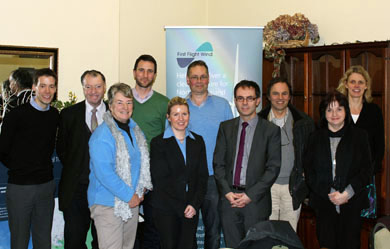First Flight Wind has recently completed its second round of technical working group meetings. These meetings are designed to allow First Flight Wind and stakeholders to discuss issues and exchange information related to the offshore project’s environmental impact.
[caption id="attachment_47380" align="alignleft" width="390"] Members of the SYLVIA working group.[/caption]
Members of the SYLVIA working group.[/caption]
There are six working groups in total, focussing on Marine Ecology; Commercial Fisheries, Seascape, Landscape and Visual Impact; Socio-Economics and Tourism; Shipping and Navigation; and Grid Connection. These groups are made up of representatives from relevant organisations and statutory bodies, as well as individual specialists.
The four most recent were held in January and February 2014. The Marine Ecology working group discussed the progress of the bird and marine mammal surveys, the potential impacts of the offshore project on birds and marine mammals, and how these impacts could be mitigated.
Murlough House hosted the second Seascape, Landscape and Visual Impact Assessment Working Group (SL
YVIA). The attendees were introduced to the subject of bringing the electricity onshore and the associated environmental and technical considerations.
The proposed geophysical and benthic surveys were discussed at the Commercial Fisheries Working Group, and John Hooper, the First Flight Wind Fishing Liaison Officer, highlighted the channels of communication being used to relay key information to fishermen.
Jack Farnham, First Flight Wind, who chaired the Socio-Economics and Tourism Working Group said: “Progress on the assessment activity has been made since the groups formed last year. Their continuing input is crucial in ensuring that all relevant issues are raised for consideration within the environmental impact assessment, and we are grateful to the stakeholders for their valuable contribution to the process.”
For more information on the technical advisory working groups, including organisations that were invited to participate, then visit:
]]>
























